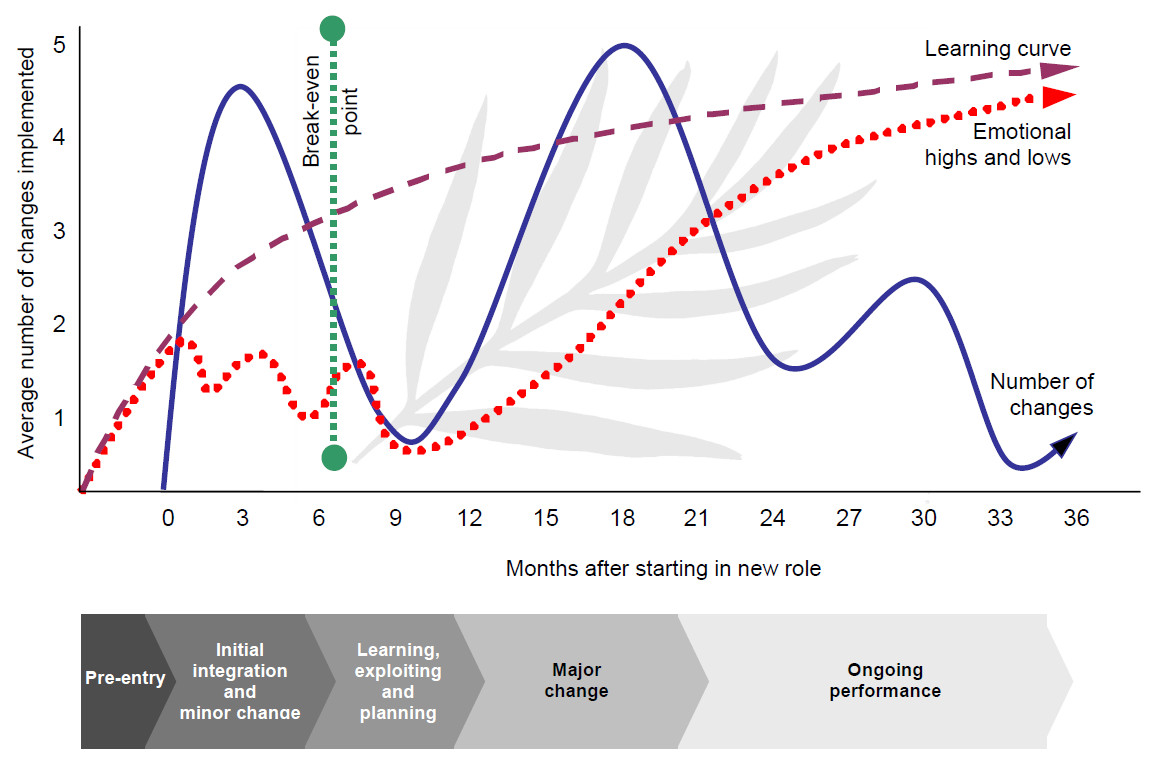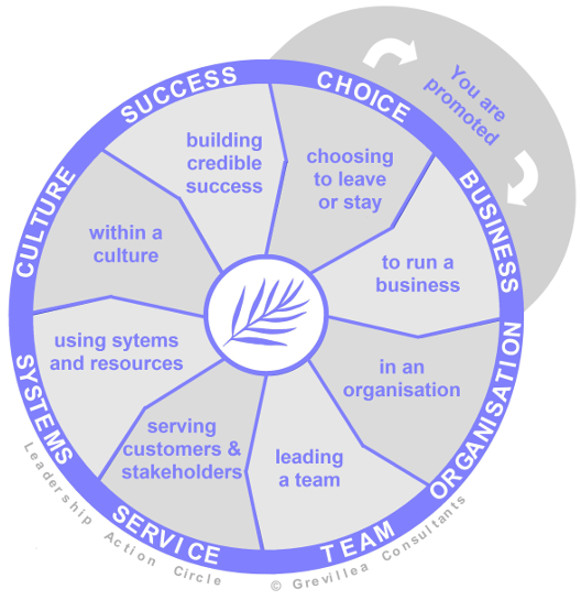What happens during transition
Failure was usually defined as disappointing results with a newly appointed leader leaving the role within 18 months. This exit may have been self-initiated or driven by the organisation. Of course, some leaders leave sooner because an opportunity for promotion arrived. This is not a transition failure but a matter of recruitment and selection in the face of emerging opportunities.
The significance of a failed leadership transition becomes obvious when the costs are collated:
- Repeated recruitment costs
- Lost productivity costs
- Team and organisational morale costs
- Brand and customer relationship costs
- Professional and public liability costs
- Training and development costs
- Missed opportunity costs
- Poor business decision costs
____________________
1. For an example of how turnover costs are calculated see: Smart, B. (2005). Topgrading: How leading companies win by hiring, coaching and keeping the best people. NJ: Prentice Hall Press.
Michael Watkins, one of the key authors in this field, proposes that accelerating the leader's journey through the transition can help the organisation reach the break-even point sooner. This is the point is where the leader is now creating value for the organisation in excess of the cost of appointing them. In his research, Watkins suggests that this typically happens around six months into the job.1
______________
1. Watkins, M. (2004). The first 90 days. Association Management, 56(8), 44–54.

A leader in transition can expect to experience:
- A sharply rising learning curve, that begins before they take up the role and doesn't level out for about 12 to 15 months. This learning process links into the changes that are noted below.
- An emotional roller coaster, where they start with an enthusiastic and confident set of emotions. This is typically by three significant emotional down times, each worse than the preceding one. This occurs in the first nine months after which their emotional state gets better and better.
- Two significant periods of implementing change. The first happens in the first six months, when the new leader can import solutions they experienced elsewhere. However, these opportunities usually dry up after about four or five noticable changes have been implemented. It then takes another 9 to 12 months, while the leader learns more about the organisation, business, issues and stakeholders, before other changes are implemented. This is around the 15 to 18 month period.
Below the chart you can see a summary of the different phases the transitioning leader goes through.
Some of the research and experience behind this chart can be found in the bibliography below, especially in the work of Watkins.
Experience and Relationships
John Gabarro's research highlighted two key factors1:
- A mismatch between prior functional experience and the new role
- Problems with two or more subordinates, peers or higher levels of management (which might be their own supervisor).
The former is a recruitment decision with transition implications. Sometimes it is important to bring in an outsider to open up new perspectives. In this case it is important to manage the need to offset the lack of technical background so the functional work of the organisation doesn't suffer.
The latter is a transition factor with recruitment implications. Building key relationships is critical and is a factor identified in other research. The recruitment process is important still, inasmuch as it can seek to filter out candidates who create releationship issues themselves, regardless of the context.
Gabarro notes that in successful transitions these factors were also present for many leaders. The difference is that they did not have as many troubles (e.g. simultaneous troubles with subordinates, peers and higher management) and had resolved most of them by the end of the first year in the role.
Expectations
Clear expectations from the leader's boss are also essential. Different researchers and practioners emphsise this differently but it is a frequent theme.2
The first emphasis is for the leader to work with their new boss to clariy what is expected. This is true at all levels. For a CEO it means working with the board and its chair. Expectations are not just about outcomes and functions. They are also about communication, levels of involvement and decision making delegations.
The second emphasis is the need for the newly appointed leader to manage expectations. This is true in any organisational setting but especially true during a transition when the person has yet to establish their credibility in the role. For example, when clarifying what the boss expect to be done or achieved, the new leader has to address expectations about time, resources, style, feasibility and quality. They have to make sure the expectations are realistic. They also have to learn what is acceptable in how they go about it. Each organisation has its own values and cultural norms.
____________
1. Gabarro, J. J. (1987). The dynamics of taking charge. Boston MA: Harvard Business School Press.
2. For a summary of the research from a coaching perspective see: Witherspoon, R., & Cannon, M. D. (2004). Coaching leaders in transition in Lessons from the field BT - Creative consulting: Innovative perspectives on management consulting, A. F. Buono (Ed.), (pp. 201–227). Information Age Publishing, Inc.
The normal sequence is to start with the you are promoted section then proceed clockwise around the diagram. However, you can move backwards and forwards throughout the diagram to any area you wish.
Make sure you look at the building credible success theme early. It contains some factors that have to be done early in the transition. These are important for a successful transition.
The Leadership Action Circle is thematic and not constructed in phases. As illustrated above, there are predictable phases. It is important to look at the actions and ask what steps are required for each phase you are in. Some actions clearly belong to a given phase, such as many of the actions in the you are promoted theme. Others, such as business planning actions, are important across all phases.
This resource was developed by reviewing available research, practitioner experience, and the experience of the author. Here is a selection of the key sources that influenced the design of the resource. They may be useful for further reading or personal development. As can be seen in the bibilography, the research into leadership role transition peaked in the decade of the 2000s. However, there are still some researchers today who are confirming the earlier work or adding to it.
Anderson, M. C. (n.d.). Executive briefing: Case study on the return on investment of executive coaching. MetrixGlobal.
Ballinger, G. A., & Schoorman, D. F. (2007). Individual reactions to leadership succession in workgroups. Academy of Management Review, 32(1), 118 136.
Bradt, G., Check, J. A., & Pedraza, J. (2006). The new leader s 100-day action plan: How to take charge, build your team and get immediate results. Wiley.
Carr, C. (1995). The new managers survival guide: All the skills you need for success. John Wiley & Sons.
Ciampa, D., & Watkins, M. (1999). Right from the start: Taking charge in a new leadership role. Harvard Business School Press.
Conger, J. A., & Nadler, D. A. (2004). When CEOs step up to fail. In MIT Sloan Management Review.
Daly, P. H., Watkins, M., & Reavis, C. (2006). The first 90 days in government: Critical success strategies for new public managers at all levels.
Davis, S. H. (2005). Should a 60 per cent success rate be acceptable? Industrial and Commercial Training, 37(7), 331 335.
Derven, M. (2008). Management onboarding. T+D, 62(4), 48 52.
Downey, D., March, T., & Berkman, A. (2001). Asimilating new leaders: The key to executive retention. AMACOM/American Management Association.
Gabarro, J. J. (1987). The dynamics of taking charge. Harvard Business School Press.
Grupe Simon Jooste, F. H., & Patel, N. (2003). Passing the baton: Helping your successor to succeed. Information Systems Management, 20(2), 19 25.
Hawke, C. (9 C.E.). Turning points: Making the transition to senior management. 2.
Johnson, J. M. (2000). Learning strategies for newly appointed leaders. In M. Goldsmith, L. Lyons, A. Freas, & R. Witherspoon (Eds.), Coaching for leadership: How the world s greatest coaches help leaders learn (1st ed., pp. 209 217). Jossey-Bass. http://www.marshallgoldsmithlibrary.com/html/books/coachLead.htm
Manchester Inc. (2001). Why Are So Many Newly Promoted Managers & Executives Failing? Manchester Inc.
O Kelley, R. (2018, December 9). CEO Transitions: Mitigating Risks and Accelerating Value Creation. Https://Corpgov.Law.Harvard.Edu/. https://corpgov.law.harvard.edu/2018/12/09/ceo-transitions-mitigating-risks-and-accelerating-value-creation/
Porter Jay W. Lorsch, Nitin Nohria, M. E. (2004). Seven surprises for new CEOs. Harvard Business Review, 82(10), 62 72. https://hbr.org/2004/10/seven-surprises-for-new-ceos#
Rowe Albert A. Cannella Jr., Debra Rankin, W. G., & Gorman, D. (2005). Leader succession and organizational performance: Integrating the common-sense, ritual scapegoating, and vicious-circle succession theories. The Leadership Quarterly, 16, 197 219.
Shen, W., & Albert A. Cannella, Jr. (2002). Revisiting the performance consequences of CEO succession: The impacts of successor type, post succession senior executive turnover, and departing CEO tenure. Academy of Management Journal, 45(4), 717 733.
Sjoberg, J. (n.d.). New leader transition meeting (Vol. 2008, Issue 11 March 2008). Sjoberg & Associates Consulting.
Smart, B. (2005). Topgrading: How leading companies win by hiring, coaching and keeping the best people. Prentice Hall Press.
Watkins, M. (2003). The first 90 days: Critical success strategies for new leaders at all levels.
Watkins, M. (2007). Help newly hired executives adapt quickly. Harvard Business Review, 85(6), 26 30.
Wiggins, T. (2019). An investigation of factors that promote and inhibit performance during leadership transitions.
Witherspoon, R., & Cannon, M. D. (2004). Coaching leaders in transition: Lessons from the field BT - Creative consulting: Innovative perspectives on management consulting (A. F. Buono, Ed.; pp. 201 227). Information Age Publishing, Inc.
Return to the Overview page.
